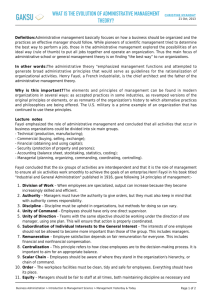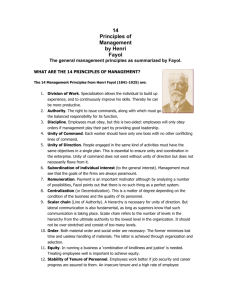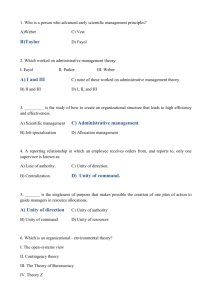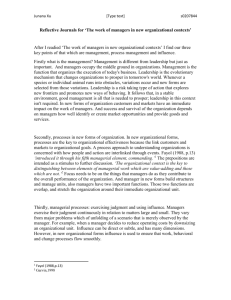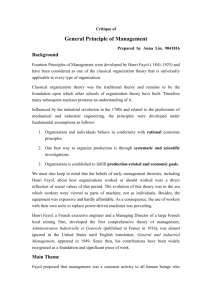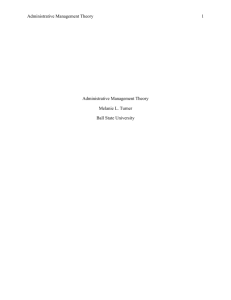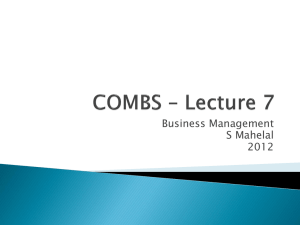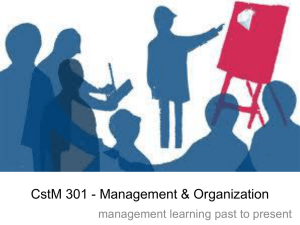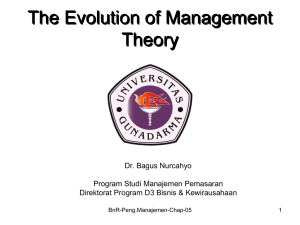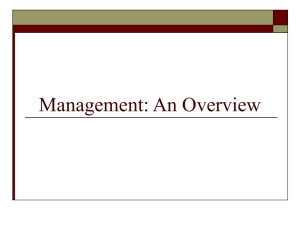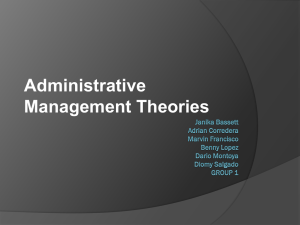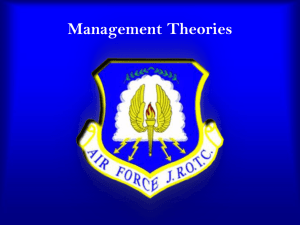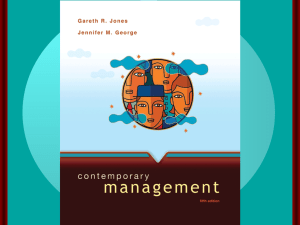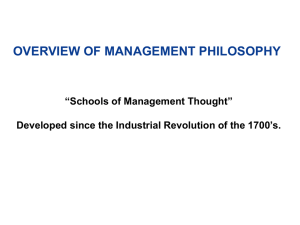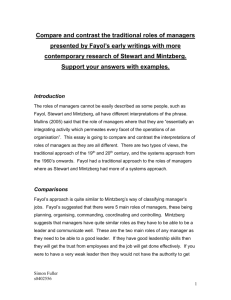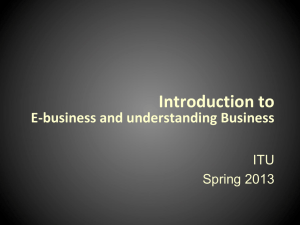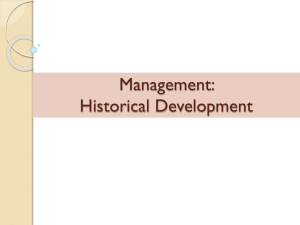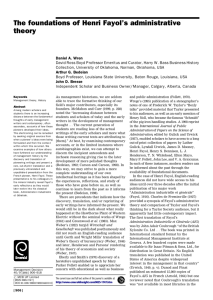File
advertisement
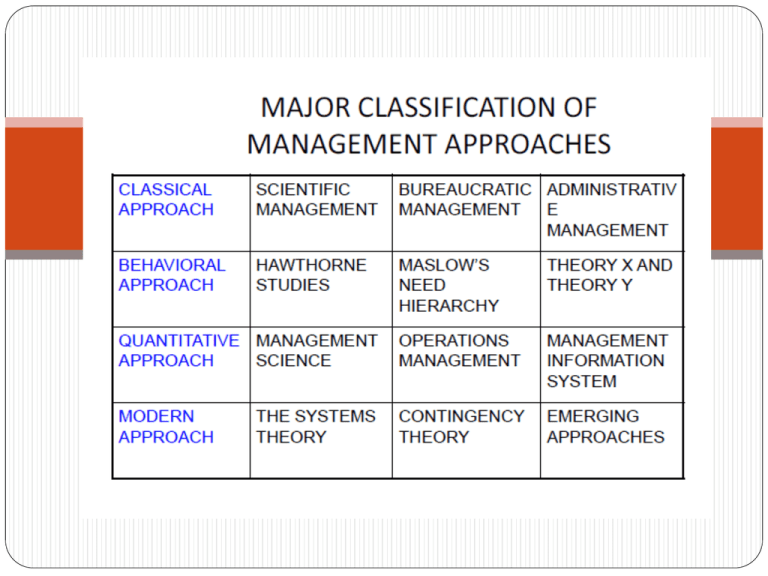
Scientific Management 1 2 3 Henri Fayol's Principles of Management Fayol's "14 principles" were first published in 1914, but are still relevant to today's managers. Today's managers have access to an amazing array of resources which they can use to improve their skills. But what about those managers who were leading the way forward 100 years ago? Managers in the early 1900s had very few external resources to draw upon to guide and develop their management practice. But thanks to early theorists like Henri Fayol (1841-1925), managers began to get the tools they needed to lead and manage more effectively. Fayol, and others like him, are responsible for building the foundations of modern management theory. Background Henri Fayol was born in Istanbul in 1841. When he was 19, he began working as an engineer at a large mining company in France. He eventually became the director, at a time when the mining company employed more than 1,000 people. Through the years, Fayol began to develop what he considered to be the 14 most important principles of management. Essentially, these explained how managers should organize and interact with staff. In 1916, two years before he stepped down as director, he published his "14 Principles of Management" in the book "Administration Industrielle et Generale." Fayol also created a list of the six primary functions of management, which go hand in hand with the Principles. Fayol's "14 Principles" was one of the earliest theories of management to be created, and remains one of the most comprehensive. He's considered to be among the most influential contributors to the modern concept of management, even though people don't refer to "The 14 Principles" often today. The theory falls under the Administrative Management school of thought (as opposed to the Scientific Management school, led by Fredrick Taylor). Fayol's 14 Principles of Management Fayol's principles are listed below: Division of Work – When employees are specialized, output can increase because they become increasingly skilled and efficient. Authority – Managers must have the authority to give orders, but they must also keep in mind that with authority comes responsibility. Discipline – Discipline must be upheld in organizations, but methods for doing so can vary. Unity of Command – Employees should have only one direct supervisor. Unity of Direction – Teams with the same objective should be working under the direction of one manager, using one plan. This will ensure that action is properly coordinated. Subordination of Individual Interests to the General Interest – The interests of one employee should not be allowed to become more important than those of the group. This includes managers. Remuneration – Employee satisfaction depends on fair remuneration for everyone. This includes financial and non-financial compensation. Centralization – This principle refers to how close employees are to the decision-making process. It is important to aim for an appropriate balance. Scalar Chain – Employees should be aware of where they stand in the organization's hierarchy, or chain of command. Order –The workplace facilities must be clean, tidy and safe for employees. Everything should have its place. Equity – Managers should be fair to staff at all times, both maintaining discipline as necessary and acting with kindness where appropriate. Stability of Tenure of Personnel – Managers should strive to minimize employee turnover. Personnel planning should be a priority. Initiative – Employees should be given the necessary level of freedom to create and carry out plans. Esprit de Corps – Organizations should strive to promote team spirit and unity. Fayol's Six Functions of Management Fayol's six primary functions of management, which go hand in hand with the Principles, are as follows: Forecasting. Planning. Organizing. Commanding. Coordinating. Controlling. Key Points Henri Fayol's "14 Principles of Management" have been a significant influence on modern management theory. His practical list of principles helped early 20th century managers learn how to organize and interact with their employees in a productive way. Although the 14 Principles aren't widely used today, they can still offer guidance for today's managers. Many of the principles are now considered to be common sense, but at the time they were revolutionary concepts for organizational management. Peter Drucker’s Management By Objectives SMART Method Specific Measurable Achievable Management by Objectives also introduced the SMART method for checking the validity of the objectives. Realistic Time-related Traditional Meaning of Management • Management is the art of getting things done through people - Mary Parker Follett • Management consists of getting things done through others…….A manager is one who accomplishes organisational objectives by directing the efforts of others. - C. S. George Limitations • May give a wrong impression of manipulation • Need and aspirations of workers ignored • Employees are merely treated as means for getting results. Modern Definition • Effective Utilisation of Resources • Management is the creation and maintenance of an internal environment in an enterprise where individuals, working in groups, can perform efficiently and effectively towards the attainment of organisational goals. Koontz and Weihrich • Management entails the utilisation of human efforts and material resources towards the achievement of organisational objectives B. M. Richman Elements • Process – Primary Functions or activities that management performs to get things done i.e. Planning, Organising, Staffing, Directing & Controlling • Effectiveness – Finishing the assigned task • Efficiency – Optimum utilisation of the deployed resources • Organisational Objectives – Synergied efforts of all towards the Org. Objectives. Management as a Process • Management refers to a series of inter-related functions or elements to achieve the stated objectives through the effective utilisation of human and other resources. Management Process • Planning – To take decisions and to prepare plans, policies, procedures, rules, etc. • Organising – Division on work and authority – responsibility • Staffing – Deployment of workforce • Directing – Instructing, motivating, leading the subordinates • Controlling – Actual vis-à-vis standards and taking corrective measures. Functions of Management Management Functions According to the functions approach managers perform certain activities to efficiently and effectively coordinate the work of others. They can be classified as 1) Planning involves defining goals, establishing strategies for achieving those goals, and developing plans to integrate and coordinate activities. 2) Organizing involves arranging and structuring work to accomplish the organization’s goals. 3) Leading involves working with and through people to accomplish organizational goals. 4) Controlling involves monitoring, comparing, and correcting work performance. Since these four management functions are integrated into the activities of managers throughout the workday, they should be viewed as an ongoing process and they need not the done in the above sequence. Levels of Management Managers can be classified by their level in the organization, particularly in traditionally structured organizations—those shaped like a pyramid 1) First-line managers (often called supervisors) are located on the lowest level of management. 2) Middle managers include all levels of management between the first-line level and the top level of the organization. 3) Top managers include managers at or near the top of the organization who are responsible for making organization-wide decisions and establishing plans and goals that affect the entire organization. The changing nature of organizations and work often requires employees in formerly nonmanagerial jobs to perform managerial activities. Non managerial jobs are those where one works directly on a job and had no one reporting to him. Mary Parker Follet defines management as, “The art of getting things done through people” PROJECT MANAGEMENT: Project management is the discipline of planning, organizing, securing and managing resources to bring about the successful completion of specific project goals and objectives. It is sometimes conflicted with program management, however technically that is actually a higher level construction: a group of related and somehow interdependent engineering projects. A project is a temporary endeavor, having a defined beginning and end (usually constrained by date, but can be by funding or deliverables), undertaken to meet unique goals and objectives usually to bring about beneficial change or added value. The temporary nature of projects stands in contrast to business as usual (or operations) which are repetitive, permanent or semi-permanent functional work to produce products or services. In practice, the management of these two systems is often found to be quite different, and as such requires the development of distinct technical skills and the adoption of separate management. The primary challenge of project management is to achieve all of the engineering project goals and objectives while honoring the preconceived project constraints. Typical constraints are scope, time, and budget the secondary—and more ambitious—challenge is to optimize the allocation and integration of inputs necessary to meet pre-defined objectives.
